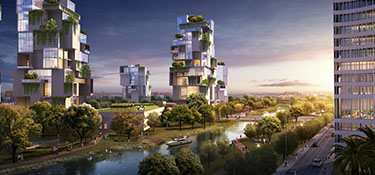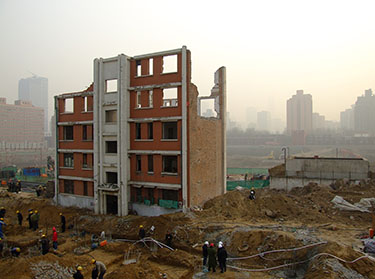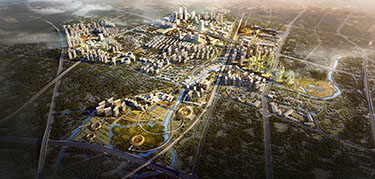|
Subscribe / Renew |
|
|
Contact Us |
|
| ► Subscribe to our Free Weekly Newsletter | |
| home | Welcome, sign in or click here to subscribe. | login |
Architecture & Engineering
| |
 |
November 29, 2018
East meets West: Planning lessons learned from China
B+H Advance Strategy

Walter
|
After 15 years living in Beijing and Shanghai designing and planning projects across China, from remote locations to mega cities, I’m struck by three significant differences since moving to Seattle: The perception of scale between East and West coasts; the drivers determining a development’s mix of uses; and how a development’s timeline can impact the outcome of projects.
A question of scale
In China, growth is happening on a massive scale. New cities materialize where industry and agriculture once stood, while vast corporate campuses bloom around elaborate infrastructure systems. The Chinese take this growth and expansion as the norm — a sign of prosperity.
Although development is happening on a large scale, there are lessons to be learned to ensure that it doesn’t eradicate the rich existing structures that work.
In Seattle, there seems to be a perception that new developments tower over buildings that existed there before. Density and height discussions focus on aesthetic and visual impact to neighbors first — and benefit for the common good last. The long-term socio-economic benefits and opportunities are often overlooked and depreciated.
Winners and losers
Projects in China set out with the highest of intentions. Clients are often driven by the desire to do whatever it takes to create truly sustainable solutions to environmental, social and economic prosperity.
Trade-offs diminish barriers that many developers face. For example, China makes it economically viable for developers to provide housing to displaced citizens and communities. Developers will build market-value housing for the displaced, and the percentage of these units is insignificant in the scale of the overall mix of market-value units within the density of the new development.
The belief is that this approach improves living standards and creates better access to jobs. However, the homogeneous norms designed to attract new residents to “destination” cities instead eradicate the cultural and historical foundations that anchor communities to a sense of place.
High tide lifts all boats
As the Puget Sound region, and Seattle in particular, strives to densify, there are lessons to be learned from China’s human-focused development practices.
Developers in Seattle can take advantage of a high tide that could lift all boats. There are tremendous opportunities to reframe our mindset towards future development, especially as we invest in new transit links that will create opportunities for better city and community building. As a city, we should:
1. Look beyond the fence. In our strategic planning practice, we invest a lot of time in thinking holistically about the mix of adjacent businesses, services and opportunities beyond site boundaries. What’s already there? What’s missing?
Thinking about how adjacent stakeholders can benefit through a shared vision creates opportunity for additional capital partners and serves the whole community, not just the development’s target population.
2. Paint an irresistible vision. The most sustainable developments are embraced by the community at-large because they create local economic engines that benefit the whole. A compelling vision of community provides desired amenities, services, jobs and social attractors. This vision becomes a narrative that animates communities and turns naysayers into strong advocates.
While the approach in the past in China has been to gamify a community through thematic approaches, future generations crave a sense of authenticity that reflects a region’s unique assets and attributes.
3. Density creates room for old and new. We can learn from one of China’s harshest lessons: Despite the government’s best intentions, the bright new developments have created enough density to support housing for existing and new populations but have no sense of history or culture. New populations struggle to bridge the economic divide that separates the new middle class from the developer’s image of prosperity for all.
As we look to solve our own increasing disparity, we need to create more than just the density to support affordable housing. We must seek to intermingle low-income and affordable units within a development that also provides easy access to well-paying jobs, childcare and support services for all segments of the population, removing the “us” from “them” stigmatization.
4. Mix, scale, flex, apply. We often overcomplicate things, but the basic ingredients are very simple. Programming is easily adaptable, the model is flexible, and each development can have a different driver: a community college, a hospital, a corporate headquarters. The secret sauce is in identifying the critical mix of social and community spaces, services and amenities that will allow each neighborhood to thrive. Residential development can’t be a driver alone.
As we plan communities, we should pay more attention to human factors that matter most. Housing is not in and of itself an economic driver. Desirable places to live offer a diverse mix of programs that create a self-sustaining, locally relevant socio-economic environment. Short-term profit margins and schedules will ultimately fall short over time if they ignore the importance of the very things that bind us.
Guy Walter is a principal at B+H Advance Strategy. For more than 25 years he has worked throughout North America, the Middle East and Asia advancing the business case for large-scale planning and urban design that is culturally, environmentally, economically and socially responsive. He recently relocated to Seattle after more than 10 years in China.
Other Stories:
- New stage for business development: sets, costumes, humor
- Survey: Sundberg Kennedy Ly-Au Young Architects
- Survey: Freiheit Architecture
- Survey: ZGF Architects
- Survey: BergerABAM
- Survey: PCS Structural Solutions
- Using insulated metal panels? It’s all in the details
- Here’s South Lake Union’s newest innovation hub
- What happens when big tech moves into small cities?
- 10 things to know about nonprofit housing developers
- Is modular the answer to affordable housing?
- Dialysis with a view: new clinics bring in nature
- Developers must ponder this: Save or scrape?
- Survey: Weber Thompson





